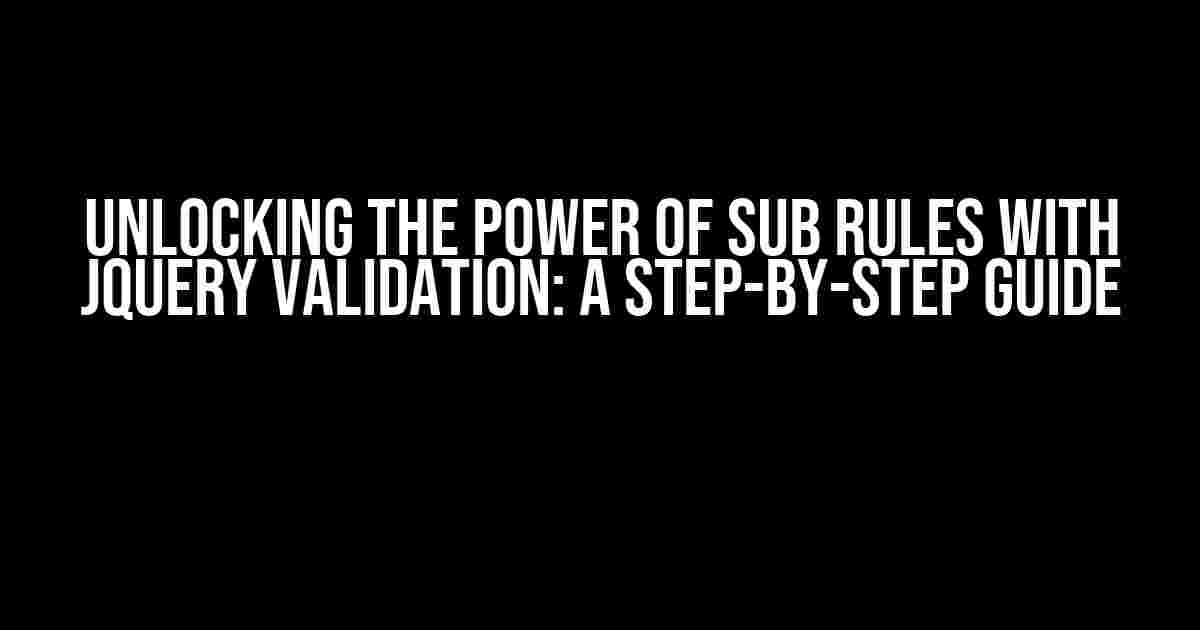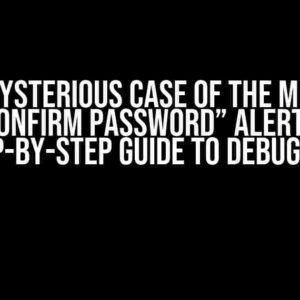In the world of web development, form validation is an essential aspect of creating a seamless user experience. With jQuery Validation, you can easily validate forms on the client-side, reducing the workload on your server and improving overall performance. One of the most powerful features of jQuery Validation is its ability to use sub rules via data-rule attributes. In this article, we’ll delve into the world of sub rules, exploring what they are, how they work, and how to use them to take your form validation to the next level.
In jQuery Validation, sub rules are a way to group multiple validation rules together, allowing you to create complex validation scenarios with ease. A sub rule is essentially a collection of rules that are applied to a specific element or group of elements. By using sub rules, you can simplify your code and make it more efficient, while also gaining more control over the validation process.
Why Use Sub Rules?”
So, why use sub rules instead of individual validation rules? Here are just a few reasons:
- Simplified Code**: Sub rules allow you to consolidate multiple rules into a single, easy-to-manage block of code. This makes it easier to read, write, and maintain your validation logic.
- Improved Performance**: By grouping rules together, you can reduce the number of validation calls made to the server, resulting in faster response times and improved overall performance.
- Increased Flexibility**: Sub rules give you the ability to create complex validation scenarios that would be difficult or impossible to achieve with individual rules.
To use sub rules with jQuery Validation, you’ll need to add the `data-rule` attribute to your HTML elements. The `data-rule` attribute allows you to specify a sub rule that will be applied to the element. Here’s an example:
<input type="text" id="username" name="username" data-rule="usernameRule">In this example, the `data-rule` attribute specifies that the `usernameRule` sub rule will be applied to the `username` input field.
To define a sub rule, you’ll need to use the `rules()` method provided by jQuery Validation. The `rules()` method allows you to specify a set of rules that will be applied to a specific element or group of elements. Here’s an example:
<script>
$(document).ready(function() {
$("#username").rules("add", {
usernameRule: {
required: true,
minlength: 6,
maxlength: 20
}
});
});
</script>In this example, the `rules()` method is used to define a sub rule called `usernameRule`. The `usernameRule` sub rule specifies that the `username` input field must be required, have a minimum length of 6 characters, and a maximum length of 20 characters.
One of the most powerful features of sub rules is their ability to be applied to multiple elements. By using a single sub rule, you can validate multiple elements with ease. Here’s an example:
<input type="text" id="username" name="username" data-rule="commonRule">
<input type="email" id="email" name="email" data-rule="commonRule">
<input type="password" id="password" name="password" data-rule="commonRule">In this example, the `commonRule` sub rule is applied to three separate input fields: `username`, `email`, and `password`. The `commonRule` sub rule can be defined as follows:
<script>
$(document).ready(function() {
$("#username, #email, #password").rules("add", {
commonRule: {
required: true
}
});
});
</script>In this example, the `commonRule` sub rule specifies that all three input fields must be required.
Sub rules can also be nested, allowing you to create complex validation scenarios with ease. Here’s an example:
<input type="text" id="username" name="username" data-rule="usernameRule">
<script>
$(document).ready(function() {
$("#username").rules("add", {
usernameRule: {
required: true,
minlength: 6,
maxlength: 20,
subRule: {
usernameFormat: {
regex: /^[a-zA-Z0-9_]+$/
}
}
}
});
});
</script>In this example, the `usernameRule` sub rule specifies that the `username` input field must be required, have a minimum length of 6 characters, and a maximum length of 20 characters. The `usernameRule` sub rule also includes a nested `usernameFormat` sub rule, which specifies that the `username` input field must match a specific regex pattern.
Sub rules can be used in a variety of real-world scenarios, including:
- Username and Password Validation**: Use sub rules to validate username and password input fields, ensuring that they meet specific requirements (e.g., minimum length, maximum length, etc.).
- Email Validation**: Use sub rules to validate email input fields, ensuring that they meet specific requirements (e.g., format, length, etc.).
- Credit Card Validation**: Use sub rules to validate credit card input fields, ensuring that they meet specific requirements (e.g., format, length, etc.).
- Address Validation**: Use sub rules to validate address input fields, ensuring that they meet specific requirements (e.g., format, length, etc.).
When using sub rules with jQuery Validation, here are some best practices to keep in mind:
- Keep It Simple**: Avoid over-complicating your sub rules by keeping them concise and easy to read.
- Use Meaningful Names**: Use meaningful names for your sub rules and rules, making it easier to understand and maintain your code.
- Test Thoroughly**: Thoroughly test your sub rules to ensure that they are working as expected.
- Keep It Organized**: Organize your sub rules in a logical and consistent manner, making it easier to manage and maintain your code.
In conclusion, using sub rules via jQuery Validation data-rule attributes is a powerful way to validate forms on the client-side. By grouping multiple validation rules together, you can create complex validation scenarios with ease, while also simplifying your code and improving performance. Whether you’re validating username and password input fields, email input fields, or credit card input fields, sub rules provide a flexible and efficient way to get the job done. So, start using sub rules today and take your form validation to the next level!
| Sub Rule | Description |
|---|---|
| usernameRule | Validates username input fields |
| emailRule | Validates email input fields |
| passwordRule | Validates password input fields |
| commonRule | Applies to multiple input fields |
By following the instructions and best practices outlined in this article, you’ll be well on your way to mastering the art of using sub rules with jQuery Validation. Happy coding!
Frequently Asked Question
Get familiar with the wonders of using sub rules via jQuery Validation data-rule attributes and resolve all your queries!
How do I define sub rules in jQuery Validation?
You can define sub rules in jQuery Validation by using the data-rule attribute followed by the sub rule name and its corresponding value. For example, data-rule-required="true" or data-rule-email="true". This allows you to add custom validation rules to your forms.
What is the purpose of the data-rule attribute in jQuery Validation?
The data-rule attribute is used to specify the validation rules for a form element. It allows you to define custom validation rules and sub rules, making it easy to validate user input and ensure that the data entered meets the required criteria.
Can I use multiple sub rules in a single validation rule?
Yes, you can use multiple sub rules in a single validation rule by separating them with a space. For example, data-rule-required="true" data-rule-email="true" data-rule-minlength="5". This allows you to apply multiple validation rules to a single form element.
How do I access the sub rule values in jQuery Validation?
You can access the sub rule values in jQuery Validation using the rules() method. For example, $('#myForm').validate().rules('myRule').required would give you the value of the required sub rule for the myRule rule.
What happens if I don’t specify a sub rule value in jQuery Validation?
If you don’t specify a sub rule value in jQuery Validation, the default value for that sub rule will be used. For example, if you don’t specify a value for the required sub rule, it will default to false. You can also specify a default value for a sub rule by adding a configuration option to the validation plugin.






